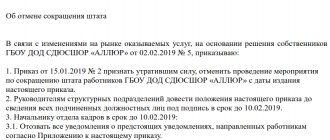The Labor Code of the Russian Federation does not regulate possible reasons for staff reductions, as well as workers. But in order to carry out the procedure, there must be a basis that shows the need to introduce a new staffing table. Reductions can be made due to a crisis or economic feasibility. In all organizations, including budgetary institutions, reductions are considered legal only if there are compelling reasons for excluding a number of positions from the staff list and dismissing employees.
Is justification needed?
The procedure for reducing the number or staff of employees requires strict compliance with all requirements of current legislation. If they are violated, the employee can have the dismissal declared illegal in court and the employer held administratively liable.
Every employee must understand the difference between downsizing and downsizing. The first option implies that a specific number of employees occupying one position are fired. At the same time, the vacancy in the organization remains. For example, a total of 6 accountants were employed at the enterprise. As a result of the staff reduction, only 2 people remained in the position of accountant. When reducing staff, it means the complete elimination of this position with the dismissal of the employees occupying it. For example, the position of sales manager was cut from the staff. All employees occupying it are subject to dismissal.
It is important to know! In such a situation, the number of employees employed in the organization does not always change, since the employer has the right to create new divisions or positions to replace the reduced one.
At the same time, the employer is not required to indicate the reason for the reduction in the notice or order of dismissal of the employee.
Sample notice of job reduction
They will be required in case of inspections by higher authorities. If the employer cannot provide documented reasons for the reduction, then he may be brought to administrative liability, recognizing the reduction as fictitious.
The law does not provide for a single document that allows the head of a company to justify in writing the procedure for dismissing employees due to layoffs. Therefore, the rationale can be presented in free form. The document must indicate the main factors that influenced the adoption of this decision. The employer has the right not to include in the text of the justification information that, if disclosed, could have a detrimental effect on the financial condition or reputation of the organization. The decision as to what data should be provided rests entirely with the director. At the same time, the presence of vague or unconvincing wording can lead to many questions from regulatory authorities.
Question: The organization plans to reduce its workforce. When should the staffing table be approved: before notifying employees about staff reduction or after two months? How long after the reduction of positions and dismissal of employees can these positions be added back to the staffing table?
Answer:
The new staffing schedule must be approved before reduction activities begin. The period during which the employer does not have the right to reintroduce a previously reduced position into the staffing table is not established by law.
Rationale: Employees are warned by the employer personally and signed by the employer about the upcoming dismissal due to a reduction in the number or staff of the organization's employees at least two months before the dismissal (Part 2 of Article 180 of the Labor Code of the Russian Federation). In this case, the new staffing table must be approved before the start of reduction measures.
It does not follow from the provisions of labor legislation how the moment of dismissal of laid-off workers and the moment of introducing a new staffing table should relate to each other. In our opinion, when employees are dismissed due to a reduction in the number or staff of the organization, a new version of the staffing table should be put into effect on the day of the employees’ dismissal (see Appeal ruling of the Volgograd Regional Court dated 09/06/2012 N 33-7811/2012).
However, there is a position that the new staffing table may come into force the next day after the dismissal of the relevant employees (indirectly confirmed by the Appeal ruling of the Tula Regional Court dated November 7, 2013 in case No. 33-2675).
The period during which the employer does not have the right to reintroduce a previously reduced position into the staffing table is not established by law.
The employer, taking into account the specifics of the activities and needs of the organization, work technology, demand for manufactured products, plans for further development and other factors, independently determines the structure and number of employees of the organization. That is, if necessary, the employer has the right at any time to make changes to the staffing table, entailing both a decrease in the number of positions (specialties, professions) or staff units required by the employer, and an increase in them.
In paragraph 10 of the Resolution of the Plenum of the Supreme Court of the Russian Federation dated March 17, 2004 N 2 “On the application by the courts of the Russian Federation of the Labor Code of the Russian Federation” it is stated that, according to Art. 8, part 1 art. 34, parts 1 and 2 art. 35 of the Constitution of the Russian Federation and paragraph. 2 hours 1 tbsp. 22 of the Labor Code of the Russian Federation, for the purpose of effective economic activity and rational property management, the employer independently, under his own responsibility, makes the necessary personnel decisions: selects, places, and dismisses personnel. That is, if an employer once decides to reduce the number (staff), then later, when he needs additional labor, he can reintroduce positions (specialties, professions) or staffing units that were previously excluded from it into the staffing table. The legislation does not establish a limiting period, before the expiration of which the employer does not have the right to introduce a previously reduced position into the staffing table.
It should be borne in mind that dismissal due to a reduction in the number (staff) of employees cannot be used solely as a way to get rid of employees unwanted by the employer. Thus, the Determination of the Constitutional Court of the Russian Federation dated December 17, 2008 N 1087-О-О indicates that termination of an employment contract on the basis of clause 2 of part 1 of Art. 81 of the Labor Code of the Russian Federation is recognized as legal provided that a reduction in the number or staff of employees actually took place (clause 2.3). The court also draws attention to the fact that it is impossible to completely exclude the possibility of abuse of rights on the part of an employer who uses a reduction in staff to fire a specific person. The validity of a reduction in the number or staff of employees is established, as a rule, by comparing the previous and new editions of the staffing table, but is not limited to this.
In the event of a dispute, the employer must prove that the change in the staffing table was caused by any objective economic, technical, organizational or other factors.
The introduction of an abolished position into the staffing table and the hiring of a new employee for this position a short period of time after the dismissal of the previous employee, in our opinion, may indicate that a reduction in the number or staff actually did not occur. In our opinion, even if the newly hired employee holds a different position, but performs a labor function similar to the labor function of the dismissed employee, termination of the employment contract under clause 2 of part 1 of Art. 81 of the Labor Code of the Russian Federation may be considered illegal. In this case, the period for an employee to go to court to appeal against dismissal is one month from the date of delivery of a copy of the dismissal order to him or from the date of issue of the work book (Part 1 of Article 392 of the Labor Code of the Russian Federation). Moreover, since a dismissed employee can learn about the reinstatement of the position he previously occupied in the staff list only after the expiration of the specified period, and since only the court establishes circumstances indicating a violation of the rights of this employee, which he did not know and could not know about at the time handing him a copy of the dismissal order or issuing a work book, the court, considering in accordance with Part 3 of Art. 392 of the Labor Code of the Russian Federation, the corresponding petition does not have the right to refuse to restore the missed procedural period without examining the factual circumstances of the case, which may serve as the basis for such restoration (clause 2.3 of the Determination of the Constitutional Court of the Russian Federation of December 17, 2008 N 1087-О-О).
Prepared based on material by O.A. Batasheva State Labor Inspectorate in the Rostov region. 01/17/2017
Legitimate reasons for layoffs
There are many legitimate reasons that may prompt the director of an organization to begin the downsizing procedure. Among the most popular it is worth highlighting:
- economic instability of the organization or the presence of financial problems that do not allow maintaining the same staff. If a company is experiencing financial difficulties, then the best option would be to downsize. It will preserve the integrity of the entire organization and the ability to continue to function;
- inefficiency of the current staff. This formulation usually implies the presence in the staffing table of positions that duplicate each other or are interchangeable;
- the use of new technologies to replace human labor with machines. This formulation is usually used when automating production, replacing outdated equipment (where human assistance was required) with more advanced equipment, or when introducing new technologies.
It is important to know! Regardless of the justification for the reduction, the head of the organization must be ready, during an inspection by higher authorities, to provide documented evidence of the reasons for the reduction. For example, provide documents about the poor financial condition of the company or confirming the use of new technologies.
To prevent the occurrence of negative aspects and labor disputes, it is recommended that the justification for the reduction be indicated in the order and notification to the employee. These activities make it possible to inform employees of the exact reasons for dismissal. At the same time, an employee who disagrees with the justification for the reduction will not be able to obtain recognition of unlawful actions by the head of the company without providing additional evidence. If, during an inspection by higher authorities, facts are revealed that make it possible to prove the fictitiousness of the measures, for example, the reduction was started only to fire a specific employee, then the directors of the company can be held accountable in court.
Read on topic:Employee’s consent to dismissal due to reduction
Read on topic: Possible reasons for staff reduction
Thus, in brief, the procedure for dismissal due to staff reduction is as follows:
- Staff reductions begin with the issuance of an order/instruction 2 months before the intended dismissal (if there are massive reductions, this period is 3 months).
- The employer has the right to carry out staff reduction procedures only after approval of the new staffing structure (schedule).
- The employer is obliged to inform local employment services about upcoming layoffs of workers 2 months in advance; for mass layoffs, the period is 3 months; for individual entrepreneurs, the period is 2 weeks.
- Categories of workers not subject to layoffs: women with children under 3 years of age; pregnant women-mothers who are raising a child under 14 years of age alone; single mothers raising a disabled child under 18 years of age.
- Employees must be notified of the upcoming layoff 2 months before the last working day (for seasonal work - 7 days, for those who have entered into a contract up to 2 months - 3 days).
- If the employer has other vacancies in the area or will appear at the time of dismissal of the employee, he is obliged to inform about this in written notice. The employee has the right to either accept this offer or refuse.
- The employer issues an order/instruction to terminate the employment agreement, the employee must sign it.
- Full payment to the employee occurs on the last working day. The employer pays wages, compensation for unused vacation and other due payments (compensations).
- If there is a dismissal due to staff reduction, the employer pays severance pay in the amount of the average monthly income, and the average monthly salary is paid by the employer for the period while the laid-off employee is looking for work, but not more than 2 months.
The amount of such payments for employees working for an individual entrepreneur is determined by the employment contract or additional agreements to it. - The work book is issued on the last working day. If the employee did not receive it due to his own fault, then it is issued upon written request within 3 days.
- When dismissing an employee, the employer is required to issue a certificate for the current and 2 previous years of work. Such a certificate is necessary for calculating benefits and other payments.
Possession of this information is very important, because when carrying out this procedure, everything must be in accordance with the letter of the law.
Recognition of the reduction as unlawful
Often, unscrupulous employers initiate layoffs to get rid of unwanted employees or ignore the legal requirements for this procedure. Thus, the actions of a manager may be considered illegal if:
- A job reduction procedure was carried out, but after a short period of time a new vacancy appeared that has similar functions and responsibilities. In such a situation, the court may declare the dismissal unlawful due to a fictitious reduction;
- a specific position was reduced, but a new one was added to the staffing table, which is similar in function to the previous one, but has a greater number of responsibilities. The court may find the reduction unfounded, since in this situation it would be more reasonable to amend the terms of the employment contract;
- The employment relationship with the employee was terminated until his vacancy was removed from the staffing table.
In such situations, the court may oblige the employer to reinstate the person in his previous position, as well as pay him money for forced absence. In this case, penalties may be applied to the organization.
According to the law, the head of the organization independently makes the decision to carry out the reduction procedure. To recognize it as fully legal, the director must comply with all provisions of the Labor Code, and also have documented justification. Otherwise, the reduction may be considered fictitious, which will lead to negative consequences for the entire organization.
Settlements with the employee. Registration procedure: types, size and terms of payments
According to labor law, the employer must pay the employee on the day the employment agreement ends and pay current wages, compensation for unused vacation and other due payments.
In addition, if a layoff occurs due to staff reduction, it is necessary to pay severance pay in the amount of the average monthly income (the average monthly income is also paid by the employer for the period while the laid-off employee is looking for work, but not more than two months).
For seasonal workers, severance pay is not paid in full, but in the amount of an average two-week salary.
If the enterprise is located in an area equated to the Far North, then severance pay is paid for 3 months.
The amount of severance pay and other payments to an employee working for a private entrepreneur is determined by the employment agreement.
Taking hormones as a reason for shortening the menstrual cycle
At first, when taking OCs, spotting or more intense bleeding may occur, which occurs 14-19 days after starting to take hormones. In this case, we are not talking about menstruation, but about bleeding. After 2-3 months of taking oral contraceptives, this phenomenon will stop. If bleeding continues to appear, you should discuss with your doctor the possibility of additional intake of antioxidants and vitamin E, since oral contraceptives provoke depletion of the reserves of these substances in the body, and a lack of vitamin E causes bleeding. In particular, the Synergin antioxidant complex is intended for such purposes.
Short menstrual cycle: is treatment necessary?
If a woman is diagnosed with pathologies of the development of internal organs, inflammatory processes, neoplasms or endometriosis, the doctor will prescribe appropriate therapy. Depending on the cause, the medications will vary. So, to restore the cycle after taking oral contraceptives, against the background of stress or for unknown reasons, the Pregnoton complex is intended. It does not contain hormones, but helps normalize the cycle and restore hormonal balance. It contains a plant component - vitex extract, which affects increased levels of prolactin, arginine, which improves blood circulation in the pelvic organs, as well as vitamins and minerals important for the functioning and regulation of the reproductive system.

THIS IS NOT AN ADVERTISING. THE MATERIAL WAS PREPARED WITH THE PARTICIPATION OF EXPERTS.
Causes and symptoms of disorders associated with a shortening of the monthly cycle
The main deviations that women may experience relate to changes in the timing of menstruation:
- Menstruation comes every 15-17 days and can be regular or irregular.
- Bleeding is greatly reduced, sometimes turning into spotting that lasts 2-3 days.
- Changes in cycle length occurred suddenly for no apparent reason.
- A woman cannot become pregnant due to lack of ovulation.
Any irregularities in the menstrual cycle should be a reason for a careful examination, since the culprit for the changes may be various diseases that require immediate treatment.
○ How to behave correctly when making redundancies?
For an employee who is on the redundancy list, you need to remember your rights:
- The first step is to check whether you are on the list of persons who cannot be dismissed due to staff reduction and whether you are taking advantage of being retained at work. If yes, then you must inform your employer in writing. The best way would be to draw up a letter in two copies, give one to the head of the enterprise, and on the second ask for a mark on receipt of the first copy. If the employer does not listen to your opinion, this will be excellent evidence for the Federal Labor Inspectorate, the prosecutor's office or the court.
- Demand that you be offered another job at the company. It is up to the employee to agree or not, but the refusal must also be recorded in writing. Otherwise, you can always refer to a violation of the law, in which case the employer will be fined and the order to dismiss you will be cancelled.
- After dismissal, you must register with the employment service within two weeks. In this case, you will be able to receive the average salary for your previous job for another two months if the service is unable to employ you during this time.
- If we are talking about staff reductions, in no case should you write a letter of resignation of your own free will or agree to dismissal by agreement of the parties. In this case, you lose the right to all benefits and payments provided by law.
[]
Reasons in the order
The reasons given for layoffs may vary . The manager has the right to independently express the basis. In particular, the following reasons can be specified:
- “due to the implementation of reorganization”;
- “in connection with personnel optimization”;
- “due to the closure of the branch”;
- “due to the difficult economic situation”;
- “in connection with organizational and staffing activities.”
Thus, the grounds for dismissal when reducing staff or personnel do not have to be specific. At the same time, one or another wording chosen by the employer cannot serve as a basis for challenging the legality of the reduction measures being taken.
If you find an error, please select a piece of text and press Ctrl+Enter.









